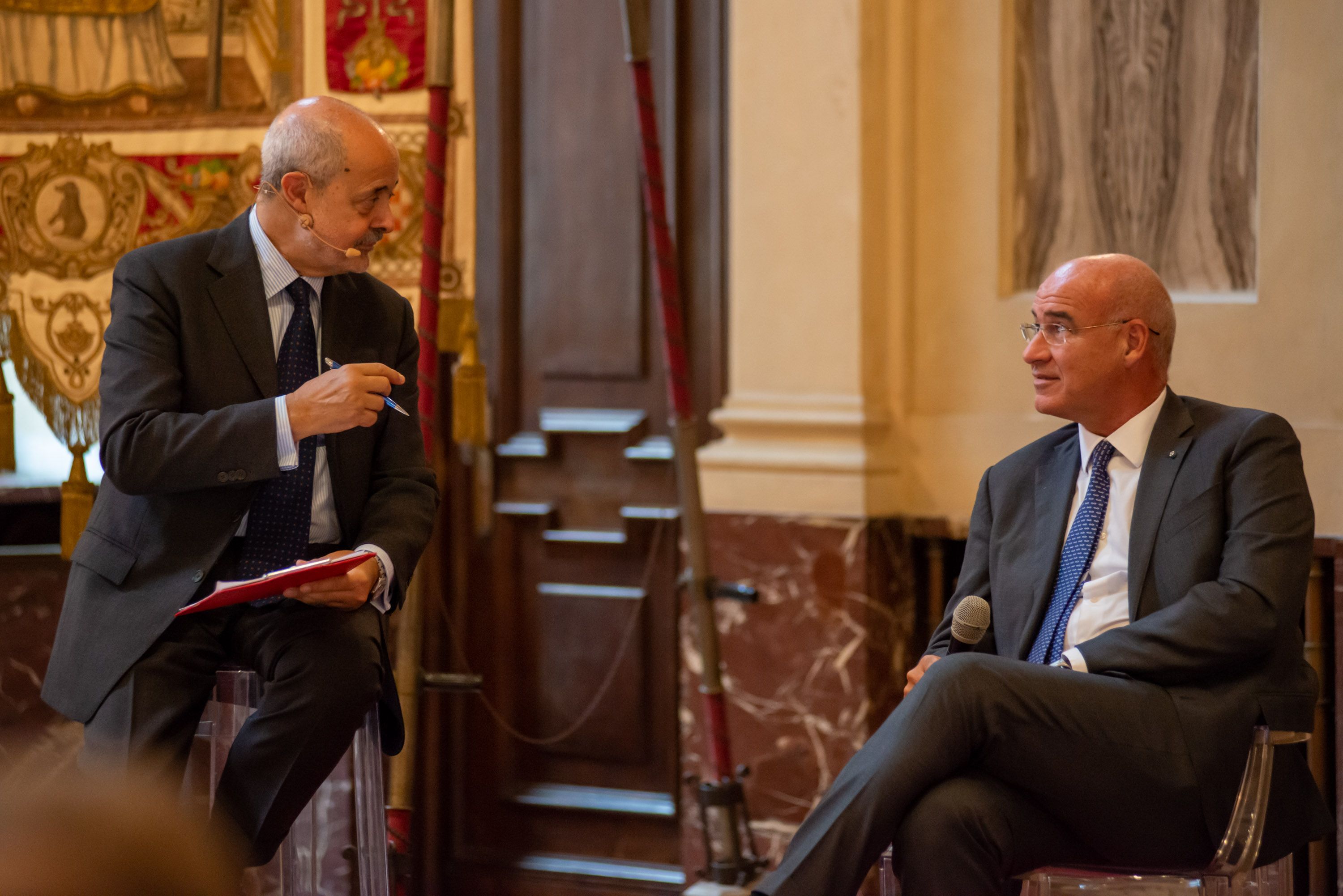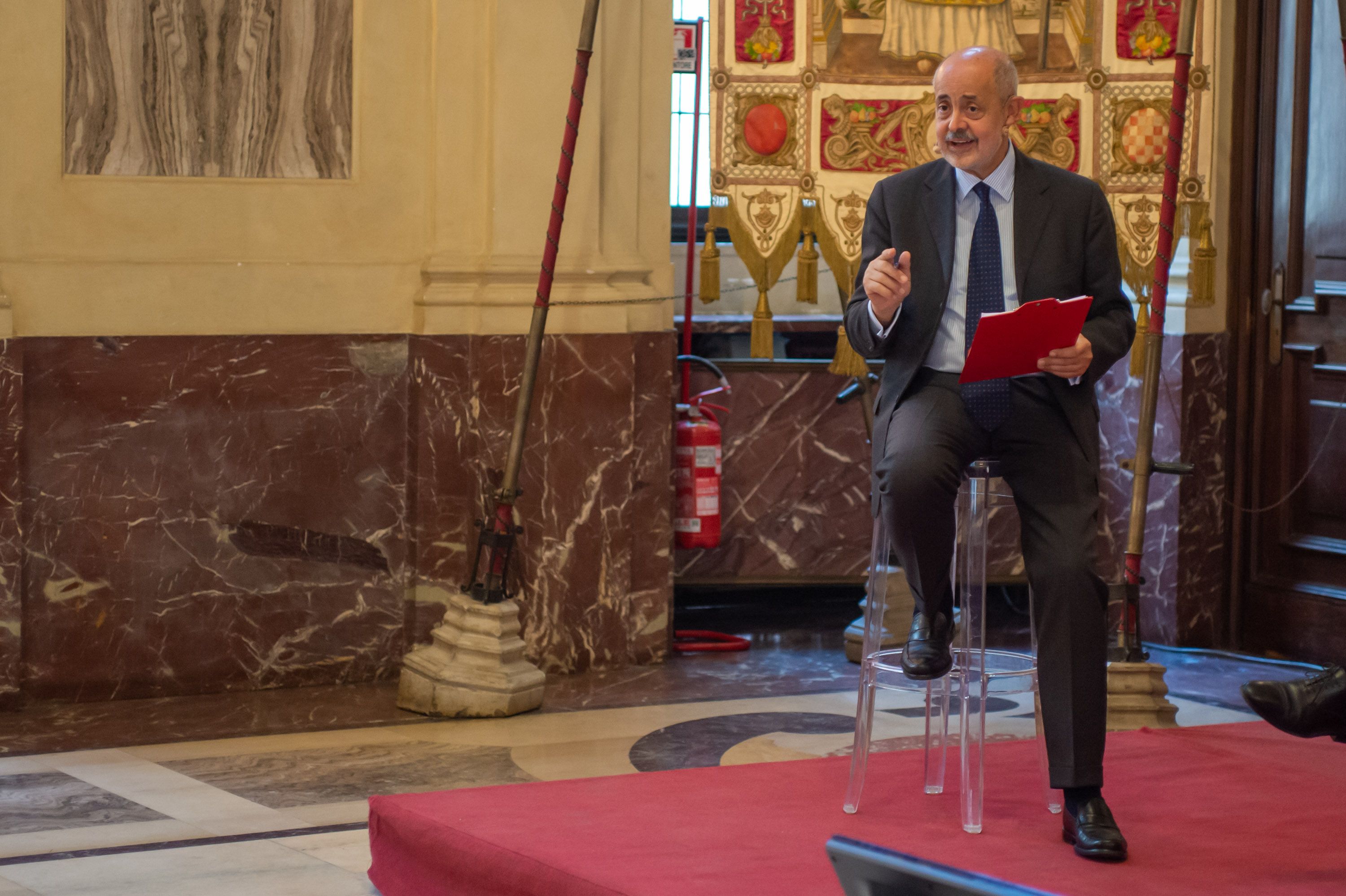“When History Builds the Future: Pirelli, 150 Years of Industry, Innovation, and Culture” at Palazzo Marino
A meeting with several speakers, on the subject of “When History Builds the Future: Pirelli, 150 Years of Industry, Innovation, and Culture”, was held at 11 a.m. today in the wonderful setting of the Sala Alessi in the Palazzo Marino, in Milan. The mayor of Milan, Giuseppe Sala, the executive vice president and chief executive officer of Pirelli, Marco Tronchetti Provera, and many other representatives of the institutions and of the academic world looked back over 150 years of a company whose history has on several occasions become intertwined with that of Italy and the world, looking to the future through the lens of innovation. Minister Maria Cristina Messa and European Commissioner for Economic and Monetary Affairs Paolo Gentiloni spoke remotely, adding their voices to those who were there in person with Ferruccio Resta, the rector of the Politecnico di Milano University, and the journalist Silvia Boccardi. The moderator was the director of the Pirelli Foundation, Antonio Calabrò. The discussion was enlivened by the screening of photographs and videos by Carlo Furgeri Gilbert, taken from our Historical Archive. These showed the forms, patterns, movements and colours of raw materials, but also experiments and people, art and culture, sport and technical innovation. They illustrated the industrial humanism that has been a fundamental aspect of Pirelli in every area of its research and in its technological development of processes and products in the rubber sector ever since 1872.
“In its history and, we are convinced, in its future, Pirelli is two things at the same time: it is quintessentially Milanese, and therefore very Italian, as well as being extremely international. In other words, it fully reflects the fundamental characteristics of this city, where Pirelli was born and where it grew up and immediately started looking out at the world” – Antonio Calabrò, Director of the Pirelli Foundation and head of Pirelli Institutional Affairs
“Companies with such a long and meaningful history – those that have been through times of error and moments of glory, and that know how the world works in all its countless forms – should be viewed with great interest and called upon to do their duty.” – Giuseppe Sala, Mayor of Milan
“This story shows us the true importance of Giovanni Battista Pirelli’s determination, strength, skill and entrepreneurship a hundred and fifty years ago. But it also shows us how important study, knowledge and science can be when it comes to making any decision. And this is a fundamental concept when knowledge and competence lead to innovation” – Maria Cristina Messa, Minister of University and Research
“During this century and a half of history, Pirelli has managed to interpret the epochal changes that have swept through both production processes and society: from the great industrial transformations to the rise of globalisation and digital technologies through to today’s leadership with regard to climate change. Pirelli’s experience offers a useful example that will help guide our economic and industrial policies” – Paolo Gentiloni, European Commissioner for Economic and Monetary Affairs
“The making of a company is always the making of the future” – Marco Tronchetti Provera, Executive Vice President, Chief Executive Officer of Pirelli
“Pirelli and the Politecnico University have worked along shared lines and some special research projects were started up fifteen years ago. The first was for the cyber tyre – a tyre with internal sensors that connected the vehicle to the infrastructure. This is what we would now call “digital transformation”. The second was into natural materials – or what we now call “green transformation”. We may not have used these words back then but the work certainly opened up a new dimension. And I would add a third dimension: these two technologies also meant thinking about how tyres needed to be made, so also the factory needed to change. And this called for an “industrial transition”, which meant accompanying the green transition and the digital transition as they changed both the labour market and the factory” – Ferruccio Resta, Rector of the Politecnico University of Milan
“These, days, consumers are no longer passive. They are extremely mindful, which means that companies must – and indeed do – have a new role to play in society. To some extent this also runs alongside that of the institutions, and indeed it must run alongside that of the institutions. At the same time, people must consume mindfully and thus put pressure on companies to renew themselves and keep up with the times” – Silvia Boccardi, Journalist and Social Equity Expert at Will Media


A meeting with several speakers, on the subject of “When History Builds the Future: Pirelli, 150 Years of Industry, Innovation, and Culture”, was held at 11 a.m. today in the wonderful setting of the Sala Alessi in the Palazzo Marino, in Milan. The mayor of Milan, Giuseppe Sala, the executive vice president and chief executive officer of Pirelli, Marco Tronchetti Provera, and many other representatives of the institutions and of the academic world looked back over 150 years of a company whose history has on several occasions become intertwined with that of Italy and the world, looking to the future through the lens of innovation. Minister Maria Cristina Messa and European Commissioner for Economic and Monetary Affairs Paolo Gentiloni spoke remotely, adding their voices to those who were there in person with Ferruccio Resta, the rector of the Politecnico di Milano University, and the journalist Silvia Boccardi. The moderator was the director of the Pirelli Foundation, Antonio Calabrò. The discussion was enlivened by the screening of photographs and videos by Carlo Furgeri Gilbert, taken from our Historical Archive. These showed the forms, patterns, movements and colours of raw materials, but also experiments and people, art and culture, sport and technical innovation. They illustrated the industrial humanism that has been a fundamental aspect of Pirelli in every area of its research and in its technological development of processes and products in the rubber sector ever since 1872.
“In its history and, we are convinced, in its future, Pirelli is two things at the same time: it is quintessentially Milanese, and therefore very Italian, as well as being extremely international. In other words, it fully reflects the fundamental characteristics of this city, where Pirelli was born and where it grew up and immediately started looking out at the world” – Antonio Calabrò, Director of the Pirelli Foundation and head of Pirelli Institutional Affairs
“Companies with such a long and meaningful history – those that have been through times of error and moments of glory, and that know how the world works in all its countless forms – should be viewed with great interest and called upon to do their duty.” – Giuseppe Sala, Mayor of Milan
“This story shows us the true importance of Giovanni Battista Pirelli’s determination, strength, skill and entrepreneurship a hundred and fifty years ago. But it also shows us how important study, knowledge and science can be when it comes to making any decision. And this is a fundamental concept when knowledge and competence lead to innovation” – Maria Cristina Messa, Minister of University and Research
“During this century and a half of history, Pirelli has managed to interpret the epochal changes that have swept through both production processes and society: from the great industrial transformations to the rise of globalisation and digital technologies through to today’s leadership with regard to climate change. Pirelli’s experience offers a useful example that will help guide our economic and industrial policies” – Paolo Gentiloni, European Commissioner for Economic and Monetary Affairs
“The making of a company is always the making of the future” – Marco Tronchetti Provera, Executive Vice President, Chief Executive Officer of Pirelli
“Pirelli and the Politecnico University have worked along shared lines and some special research projects were started up fifteen years ago. The first was for the cyber tyre – a tyre with internal sensors that connected the vehicle to the infrastructure. This is what we would now call “digital transformation”. The second was into natural materials – or what we now call “green transformation”. We may not have used these words back then but the work certainly opened up a new dimension. And I would add a third dimension: these two technologies also meant thinking about how tyres needed to be made, so also the factory needed to change. And this called for an “industrial transition”, which meant accompanying the green transition and the digital transition as they changed both the labour market and the factory” – Ferruccio Resta, Rector of the Politecnico University of Milan
“These, days, consumers are no longer passive. They are extremely mindful, which means that companies must – and indeed do – have a new role to play in society. To some extent this also runs alongside that of the institutions, and indeed it must run alongside that of the institutions. At the same time, people must consume mindfully and thus put pressure on companies to renew themselves and keep up with the times” – Silvia Boccardi, Journalist and Social Equity Expert at Will Media










